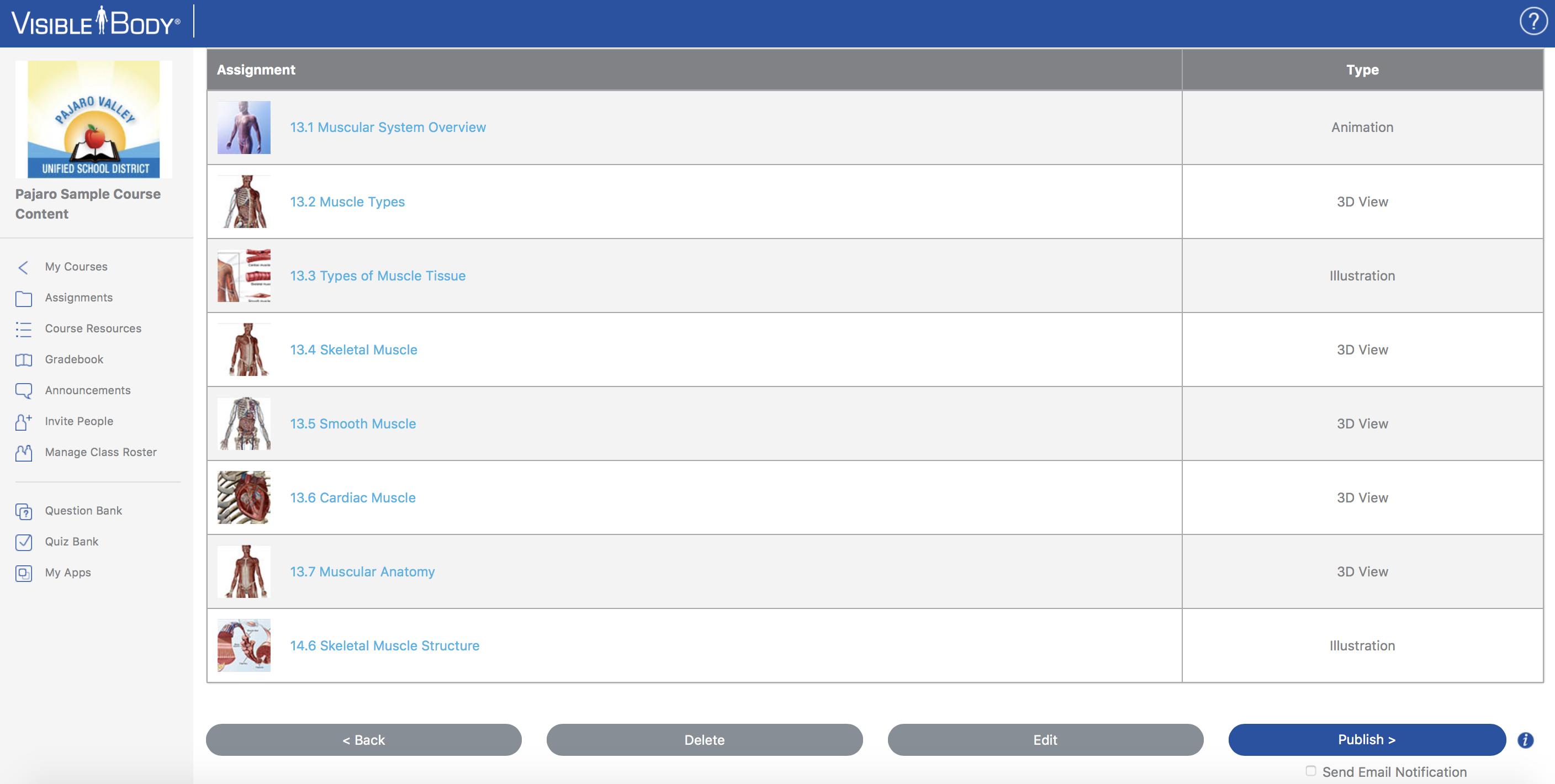How Students Interact with Visible Body’s Courseware
Posted on 11/26/18 by Jess Pitocco
Last week the VB Team spoke with Jared Bradley about starting an instructor trial of Courseware for his sports medicine students at Pajaro Valley High School. During his first week, he lectured with the 3D models and animations in Courseware. We are checking in with him on the second week of his trial: now students have access to Courseware on their Chromebooks and are starting to complete in-class assignments with this Visible Body platform.
What lesson did you start with in Courseware? How did you try to implement it into your current curriculum?
I took two assignments, an introduction to muscle tissues and skeletal muscle actions, and had students complete the assignment by finding the answers in specific content from Courseware. I gave them the same Google doc in Google Classroom that I had before. Here is an example list from the introduction to muscle tissue and functions assignments.
 These are Jared's assignments for the muscle tissue content that is available to students in Visible Body Courseware.
These are Jared's assignments for the muscle tissue content that is available to students in Visible Body Courseware.
For the introduction to muscles tissues, I introduced the topic using Visible Body to lecture and gave the students my assignment handouts. Then students worked on their own. I had the them identifying muscles and structures, as well as learning their key functions, features, and differences.
The students went over muscle types, dissected smooth and cardiac tissues, and searched for specific muscles within in program to highlight and take notes on. They will use their notes on the muscles we went over in class to take quizzes I assign later.
How long did it take students to learn how to use the 3D models and animations in Visible Body Courseware?
The students figured out how to rotate the model, it was pretty self-explanatory. They are used to tinkering around with technology.
The only things I pointed out were:
- How to select to open the content box for each muscle. From there, I told them what info they needed to know from that description for the class assignment.
- During the lecture, I highlighted the multi-select tool and the hide and fade tools as well.
They’re all really smart and tech savvy; they were figuring it out easily.
How did students react to and interact with the 3D models and animations during the lecture?
They liked it. I was able to lecture and encourage them to look up from their computers. Some of the good students were looking down to take notes, other students were just following along. I wanted them to be following along with the lecture notes in a Google document.
This muscle action lecture was more successful as far as getting them to look at the models and take more notes. They learned the muscles of the head and neck. I had them do the actions and movements along with the 3D animations; moving in their seats made them more engaged.
The 3D muscle actions in Human Anatomy Atlas, can be zoomed, rotated, and viewed from many angles. Students can practice the actions on screen, or use mobile phones to try the actions in virtual reality. In this lesson, students learned about head rotation and head neck flexion which are the muscles actions we use to say yes and no!
These topics seem very in-depth for high school students.
The class is actually college credit-transferable. Students would be able to transfer this class credit over to an intro class they would take at UC or a community college. The curriculum is mapped to the University of California College (UC) curriculum.
In addition to all this anatomy content, assignments, and quizzes, my students have a research presentation at the end of the year. They also come into the training room at the school and learn different taping and stretching exercises for athletes. They get paired up with an injured athlete and go through an initial injury evaluation and rehab process. They learn how to document all this. The course is a mix of course objectives like books and reading knowledge with technical skills knowledge.
What do you think of this Visible Body Courseware trial so far?
I was getting bored of PowerPoints and videos and quizzes, and I noticed my students were getting bored too. I wanted to be more modern, so I tried Courseware!
Did you encounter any problems during the lecture or class assignments?
The computer I was using to hook up to the projector for lecture was old and the muscle actions were dragging a bit on it. Next time I need to hook up my Chromebook to the projector.
(Courseware works on a number of desktop computers. Another option, because the computer in the classroom is very old, is to try lecture by connecting the mobile version of the apps to the classroom projector.)
What are you trying next week?
I’m going to continue with the muscle actions next and move down to the chest and abdominal area, and then maybe a little bit of hip muscles, and finish with lower half of the body.
I use Kahoot! quizzes that I grade along with assignments, and I will eventually start using Visible Body quizzes to be graded instead of Kahoot!. I will test out Courseware’s graded quiz function. I think that’ll make it easier for me in the long run, having the gradebook on Visible Body, and then just copy and pasting it into the school grading program.
A big thank to Jeff Bradley for sharing his thoughts on his second week using an instructor Courseware trial! We’ll check in again to see how well the students did with quizzing in Courseware, and what’s next for his course.



